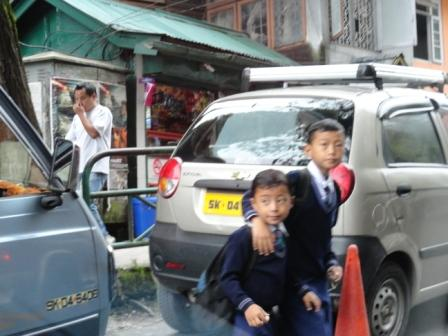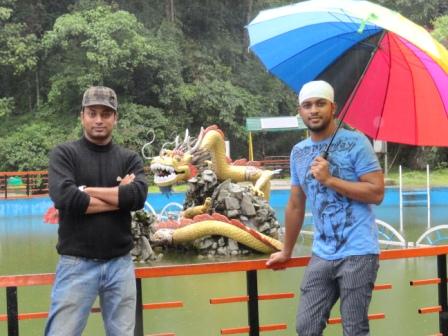It was Darjeeling that I was heading for but a chat with tourists on the train from Kolkata to Siliguri changed the destination. According to them Darjeeling just had scenic beauty but Gangtok was a beautiful city as well. Gangtok, the capital city of Sikkim sounded exotic and not just romantic as Darjeeling. Indians don’t need a passport to visit as it was decades ago because Sikkim joined the Indian Union in 1975.
While the train was nearing Siliguri the paddy fields on either side were giving way to shrub like plants of tea estates. The train had been chugging up for hours and was now a few hundred meters above sea level where the climate was suitable for tea to grow. On the horizon was a silhouette of gray mountains and I was told that the twinkling lights visible on the ridge line were from Shillong, the capital of Indian State Meghalaya. I had a colleague Ghosh in Airforce who hailed from Shillong. He once brought a bottle of red chilly pickles which he said was very famous in his region. The chilies were tiny but when tasted shot through the tongue like an atomic explosion. Passengers with me smilingly nodded in agreement with my description of the unforgettable Shillong chilly. Should you need further confirmation check out “world’s hottest chilies” on http://www.gatewaytoindia.in/india-by-city/shillong/

The train reached Siliguri the West Bengal town that is the main gateway to Sikkim, on time. It was not even 8 pm but all shops on the way to Market Road where good lodgings were said to be available were already closed. Hiring and perching on a rickshaw that was moving leisurely I saw many people on the streets with the characteristic physical features of the hilly North Eastern states of India – short stature with smaller eyes and fair skin. The manager of the lodge I booked in kindly advised it was better to start for Gangtok as early as possible in the morning.

There is no railway or airway to Gangtok and SUV’s are the main transportation. The journey takes 4 hours and the fare Rs. 150/- per person.
The ride was fast and smooth till it reached the foothills of the mountains after Sevok, a small town. Then the road ceases to have any resemblance to a national highway and becomes a narrow and bumpy way. The vehicles had to stop a few times due to landslips and “sinking” roads.

On the West Bengal – Sikkim border a wiry and pale-faced cop who looked more South East Asian than Indian sent a momentary chill into the SUV by barking, “ID cards out!”. But it was to be just a routine shout. Before everyone whipped his ID Card out the SUV moved on and the cop was peering into the next vehicle behind. Early on the journey, I saw a dam being built on the River Teesta which originates in the Himalayas in northern Sikkim and runs across almost the entire length of the state. Fed by melting snows of the Himalayas and monsoon rains it reaches the plain of the West Bengal state of India and then crossing into Bangladesh merges with the great river the Brahmaputra. (Sharing of the waters of Teesta has been a contentious issue between India and Bangladesh. The Chief Minister of West Bengal has recently refused to sign an agreement with the Prime minister of Bangladesh on the sharing of the river waters.)

It was sloping terrain all around and one could hardly see a plateau anywhere. There was a student of Manipal Sikkim University who was a co-passenger with me and when we halted at a roadside eatery he insisted that I taste momo. I was not too keen to eat some spice-less food out of politeness but when I chewed on the steam-cooked momos served with traditional red hot tomato pickle I liked it instantly and thereafter always looked forward to it as a snack or meal.
On approaching Gangtok the traffic started to crawl and the roadside views were no more scenic but of muti-storied buildings, old and new, like in most north Indian towns. The SUV finally ended the journey mid a sloping road that led to a basement parking lot filled tightly with SUV’s. If I was missing any plateau on my way up I was at a loss for even a flat foot-hold. Every road was sloping up or down or curving and every building stood precariously clinging to the hill slopes. It was pretty to look at but shudder to think. I wondered if they could ever build an airport here since the longest flat stretch I saw was the city center road just about 50 mt wide and 200 meters long. If there is an earthquake it seemed parts of Gangtok, if not the whole of it, would topple down the slopes. (A few weeks later a 6.9 Richter scale earthquake hit Sikkim. According to news agency reports, there were about 70 deaths, damages to 100,000 buildings, and over 25 landslips on the road from Siliguri to Gangtok.)

The main market road of Gangtok
Two breathtaking sights to see during the Gangtok visit are the snow-covered Nathula-Pass and Kanchenjunga, the third highest mountain peak in the world. Special permits are to be taken for visiting Nathula as it is a border post between India and China but the lodges/hotels arrange them as well as transportation for the boarders. Foreigners have a more stringent procedure for permits. There is a charge of Rs. 100/- per visitor (Indian). It was interesting to see a billboard from the Indian Army near the main Sikkim tourist center clarifying that it is not the Indian Army but the Sikkim govt. that collects charges. The announcement aimed at improving Army’s public relations goes on to invite every visitor to Nathula for a free cup of tea at its camp! The journey to Nathula takes hours on SUV on narrower and more precarious roads and as the weather became foggy I didn’t mind giving it a miss. Kangchenjunga can be seen early in the morning from many a hotel room itself if the weather is good even for a few moments. Posted below is a captivating picture of the peak from the net.

The earliest known reference to Sikkim in historic records speaks of one Buddhist Guru Rinpoche’s visit and blessing of the land in the 9th century AD. The original inhabitants of Sikkim are believed to be Lepcha tribals who came from the far east and they developed a language that was a mix of Tibetan and Burmese (Language of Myanmar). The tribals first converted to Buddhism and after the arrival of the British re-converted to Christianity. Other major settlers in Sikkim called Bhutias came from Tibet in the 14th century AD. But nearly 70% of the present population is from neighboring Nepal who came in the 19th century.
I learned from fellow tourists and a native cabman that people from outside Sikkim, mainly from Kolkata consider Gangtok a good place to invest in real estate and build holiday homes. The heavily crowded streets and frequent traffic congestion in Gangtok may be a result of this trend.

There are taxis doing day tours of Gangtok on a share basis and it worked out to Rs. 300 per person. The trip included going to the highest point in Gangtok called Ganeshtok and visits to waterfalls, parks, and also a ride on a cable car.

From the cable car vehicles and houses below looked like pretty toys but the crew were so anxious about balancing the cabin passenger load that practically all had to stand with their feet planted at one place and twist only their trunks and heads to view around which was odd and funny.


The tour involved a good deal of walking on hilly roads and short cutting through tall stairways that were winding up through hairpin bends. There was a govt. built amusement park with artificial falls, ponds and bridges where my fellow tourists Arghya and Abhijit from Kolkata obliged me for a photo.


We visited a monastery atop a hill with a lot of Sikkimese monks, lamps and prayer wheels. Lot of kids with shaven heads in monk dress were seen in and around them. It is said sections of the people of Sikkim send a kid from each family to become a monk. That might make the Sikkim Buddhist missions unique with probably the highest proportion of kid monks among all religious communities.



Finally, I was happy to find a cafe serving dosas with sambar and coconut chatni down the road next to the main market. It was served in cups and plates made of dried leaves which reminded us that Gangtok prides itself as one of the earliest plastic-free cities in the country. (There was still a plastic spoon with my dosa, though.) How this was achieved is detailed in an article titled ‘Plastic-free Gangtok: A Success Story’ here: mdoner.gov.in/storiesdetails.asp The man at the service counter spoke a few Tamil words proudly impressing his boss and me. He said he had been to Kerala but exclaimed it was too far. I too shared his sense of the distance as I, traveling from the far south, felt the same way about Sikkim.

After a couple of days, it was again a four-hour journey on a shared SUV to return to the plain. It was a memorable trip; made the body fitter and mind free from usual thoughts. I also understood why some people want the whole of their life to be a long holiday.
[Originally posted on 11th September 2011 at jothicharles.wordpress.com]
